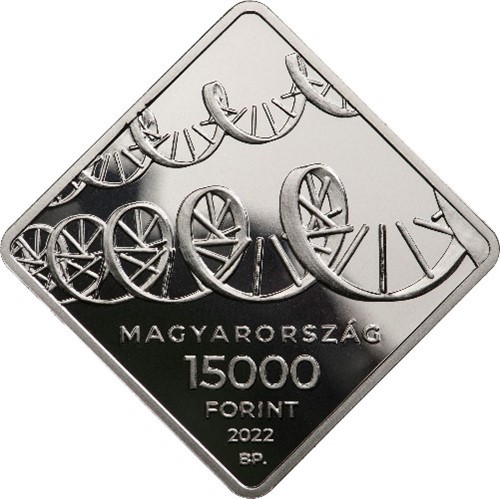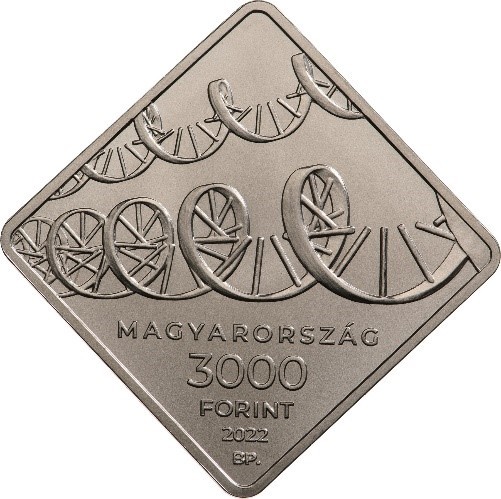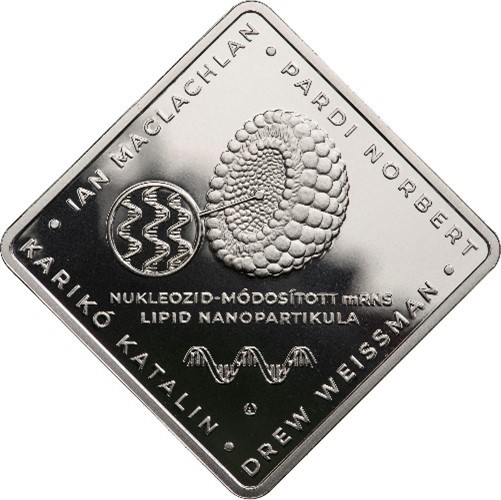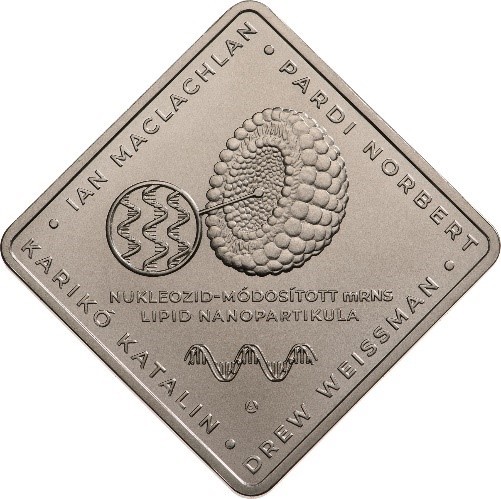Today, the Magyar Nemzeti Bank is issuing a silver collector coin named ‘Az mRNS-alapú vakcinák alapjául szolgáló magyar találmány’ (The Hungarian invention providing the basis for mRNA-vaccines) with a face value of 15,000 forints and its non-ferrous metal version of 3,000 forints at the University of Szeged. Designed by applied artist András Szilos, the rectangular collector coins, tilted on one tip, present the essence of the invention listing the Hungarian, American and Canadian scientists who played a key role in the research.
Developed jointly by several researchers, messenger RNA (mRNA) vaccines, aimed to combat COVID-19 infection, played a crucial role in the protection against the SARS-CoV-2 virus and the repression of the global pandemic that broke out in 2020. Two Hungarian scientists outshine the rest, namely Katalin Karikó and Norbert Pardi. As a result of Ms Karikó’s efforts, injecting the mRNA molecule in the human body became safe and by putting the mRNA in fat molecules, Mr Pardi eliminated its instability rendering the injection of mRNA into cells effective.
Based on research of recent decades it became clear that synthetically produced mRNA, encoding viral proteins, injected into the human body, might offer protection against different virus infections. Using the mRNA, the cells produce the necessary section of the virus protein that might cause problems inside the human body, and in response, our immune system starts producing antibodies (and often other special immune cells) enabling the body to fight the virus. The cells in the human body consider the mRNA molecules, encoding viral proteins, as foreign material; however, as a result of the modifications, the mRNA molecules can complete their therapeutic tasks safely and effectively.
This success provides basis to future mRNA vaccine developments for such crucial pathogens as the influenza virus, herpesvirus and the HIV. In addition, several new applications will appear through using mRNA-based medicine for instance treating incurable diseases with gene editing therapy, developing a vaccine against cancer. The development and testing of the two key elements of the vaccine platform (mRNA with modified nucleoside and a carrier lipid nanoparticle) is the result of steadfast research of several decades.
The Magyar Nemzeti Bank is issuing a silver collector coin of 15,000 forints and its non-ferrous metal version of 3,000 forints to honour the results achieved by scientists participating in the research, and their perseverance. The primary function of the coins is to raise awareness, they have no role in coin circulation. The silver and non-ferrous metal coins have the same design, the only difference being the denominations.
On the obverse, a stylised representation of two modified messenger RNA molecules (mRNA) is featured as the central motif with the compulsory elements of collector coins in five lines: the inscription ‘MAGYARORSZÁG’ (Hungary) referring to the issuer, the denominations ‘15000’ and ‘3000’, the lettering ‘FORINT’, the mint year ‘2022’ and the mint mark ‘BP.’.
The obverse of the ‘Az mRNS alapú vakcinák alapjául szolgáló magyar találmány’ collector coins
|
Silver collector coin |
Non-ferrous metal collector coin |
An mRNA lipid nanoparticle modified with a nucleosoide constitutes the central motif on the reverse, which is a fat particle including the modified mRNA spirals. The mRNA spirals are magnified and placed next to the fat particle. The essence of this invention is to safely inject the therapeutic mRNA into the human body, to enable it to perform its tasks effectively. Therefore, the RNA is packed in a fat particle also known as a lipid nanoparticle. Underneath, in two lines the lettering ‘nukleozid-módosított mRNS lipid nanopartikula’ (mRNA lipid nanoparticle modified with nucleosoide) is read. Under the inscription, a stylised representation of an mRNA spiral with the master mark of applied artist András Szilos, the designer of the coin, is seen.
Separated with a dot, running clockwise, the names of the scientists playing a key role in mRNA-based vaccine research are shown on the edge of the coin: ‘KARIKÓ KATALIN’, ’IAN MACLACHLAN’, ‘PARDI NORBERT’, ‘DREW WEISSMAN’.
The reverse of the ‘Az mRNS alapú vakcinák alapjául szolgáló magyar találmány’ collector coins
|
Silver collector coin |
Non-ferrous metal collector coin |
The sides of the coins are 38.61 mm long, their edges are smooth.
The collector coin of 15,000 forints was struck in .925 fine silver, weighing 31.46 grams, the non-ferrous metal coin with a face value of HUF 3000 is produced from an alloy of copper (75%) and nickel (25%) and it weighs 38.50 grams. The mintage limit of the silver commemorative coins is 10,000 pieces in proof finish and that of the non-ferrous metal is 15,000 pieces in BU finish.
In order to promote the value transferring and educational role collector coins have, as widely as possible, the ‘Az mRNS alapú vakcinák alapjául szolgáló magyar találmány’ silver coins will be available for purchase at their face value for three months and their non-ferrous commemorative versions for one year in the coin shop of the Hungarian Mint, the producer and distributor of the coins (Budapest, distr. V, 7 Báthory street), and in its webshop (https://www.penzvero.hu/) from 10 March 2022, while supplies last.



